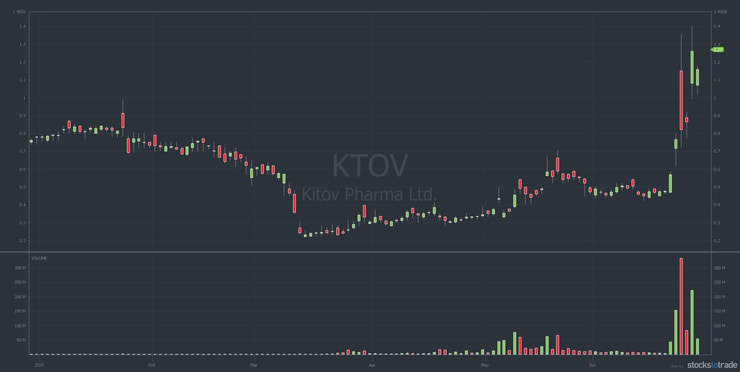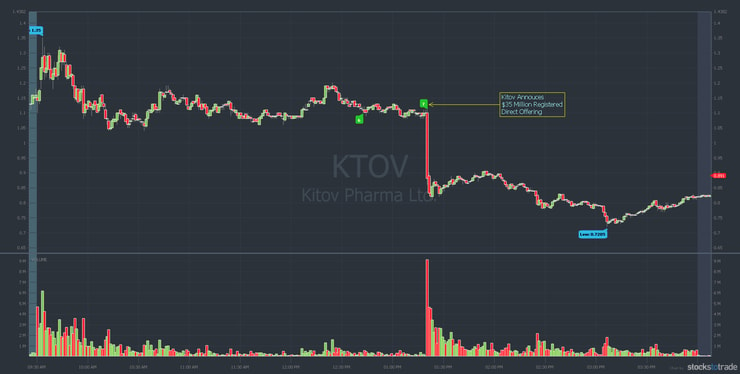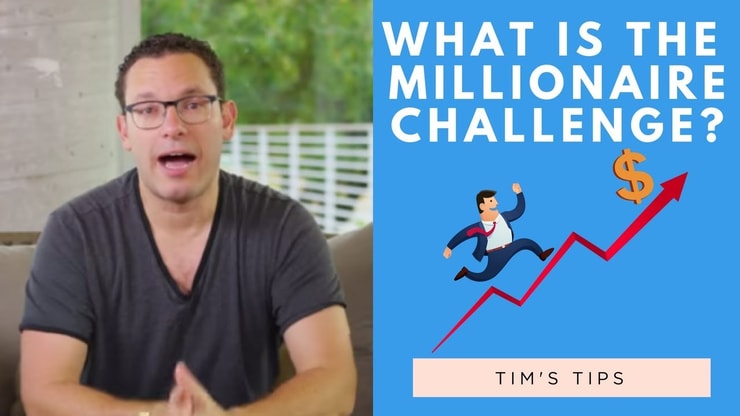Every trader needs to understand penny stock dilution and why stocks get pumped. Too many newbies trust the pumpers and lose their hard-earned money. Worse, they walk away feeling cheated.
Then they think penny stocks are bad. But it’s all part of the game. You just need to know…
Table of Contents
- 1 Why Penny Stocks Get Pumped
- 2 What Is Penny Stock Dilution?
- 3 How Penny Stocks Get Pumped
- 4 Learn to Trade the Volatility
- 5 Learn More About Penny Stock Dilution and Stock Pumps
- 6 Trading Challenge
Why Penny Stocks Get Pumped
99% of penny stock companies fail.
If the companies all fail, why do they exist? Are they small companies trying to create great products? Or do they exist to sell shares?
I’m not here to make those judgments. Nor am I here to say what’s legal and/or ethical. My goal is to educate you about what actually happens.
Follow the Money
Most of these companies couldn’t stay in business if they didn’t raise cash regularly. And many of them have no revenue. So they start issuing press releases galore. If the ‘news’ is good enough, maybe the stock runs.
But if the stock gets pumped on Twitter, StockTwits, or WhatsApp, it can really spike. When it does spike … that’s when the action behind the smokescreen happens.
How do they do it? An offering or financing. The end result is penny stock dilution.
What Is Penny Stock Dilution?
Penny stock dilution is when a nano- or micro-cap company issues new shares into the market. For example, say a company has a float of 10 million shares. If they sell two million new shares into the market, the new float is 12 million shares. Easy, right?
But what about market capitalization? If the stock’s price was $1 per share before the offering, the market cap is $10 million. All things being equal, the market cap would still be $10 million after the offering.
What does that mean for the value of a share? Putting it bluntly, it drops. That $1 stock is now worth roughly 83 cents per diluted share.
Here’s how it works…
What Is a Shelf Offering?
A shelf offering allows a company to raise money any time within three years of the registration. It’s perfectly legal and permitted by the Securities and Exchange Commission (SEC).
Effectively, a shelf offering is pre-registration of equities with the SEC. For U.S.-based companies, the filing is an S-3. For foreign-based companies trading U.S. equity markets, it’s an F-3. It provides details like the number of new shares and the total dollar amount of the offering.
But one of the most important things to know about shelf offerings lies in the name…
Shelf Offering: Put It on the Shelf Until We Need It
The shelf offering lets the company put the shares on the shelf.
Again, the company has up to three years to introduce the new shares into the market. This keeps the company from having to re-register. It also saves the company from incurring penalties if it issues shares to raise cash in a hurry.
Also, if the company doesn’t sell all the registered equities within three years, it can roll them over. It only needs to file an updated S-3 or F-3. It happens often.
Why would the company want to wait? So it can get the best price for the new shares. When a company sells shares into the market, it dilutes the shares, right? So it’s in the company’s best interest for the share price to be as high as possible before they sell.
Enter the pumpers…
How Penny Stocks Get Pumped
Let me say up front … I’m not against the pumpers. But it’s my job to educate you. My problem with pumpers is that they’re not telling the whole story. They’re saying things like…
“This one is going to the moon!” Or … “The new technology will change the world!” Or … “The company is about to sign a big contract!”
What most newbies don’t understand is … that kind of hype isn’t new.
Learn From the Past
In the past, promoters used boiler room marketing calls at dinnertime. (Think “Wolf of Wall Street.”) They also used emails, postcards, and other direct mail.
They even used to send out DVDs in the mail. These glossy marketing packages enticed financially uneducated people to buy stocks. But it was all BS promotion of sketchy, unprofitable companies.
Then a few years back, the SEC cracked down. They made it a lot more difficult for the pumpers. They forced the…
Evolution of the Penny Stock Pump
Now the pumps happen in different places using different media. Gone are the days when you got the 6 p.m. call from the boiler room scammers.
Now it’s done on Twitter or StockTwits. There are WhatsApp, Discord, and Telegram group chats. And you still see email promotions. But the list owners have to disclose marketing arrangements in the emails. So they’re not as effective.
The most important thing to understand is…
It’s the same message using different media.
Let’s look at an example of a pumped stock. I’ll show you what to look for and where to find it.
[Fair disclosure: I’m not accusing the company of wrongdoing. It appears to be in compliance with SEC rules. This is an example of what happens when a shelf takedown happens.]
Kitov Pharma Ltd (NASDAQ: KTOV)
Kitov Pharma Ltd is a development stage biopharmaceutical company based in Israel. The company filed an F-3 on December 12, 2019. Remember, an F-3 is the same as an S-3, but it applies to foreign companies.
From the F-3, it’s not clear how much cash the company could raise. You can find that number in an F-1 filing from December 27, 2019. The proposed max amount was $35 million. How does a company determine that number? It’s calculated, at least in part, based on the company’s market capitalization and public float.
Watch this video for more on how to read SEC filings:
How to Read SEC Filings (Live Trading)
The SEC has rules about how the S-3/F-3 shelf offering works. The document explaining it is 70 pages long. I won’t bore you with details, but the simplified version is…
Baby Shelf Registration: Rule I.B.6
General instruction I.B.6 restricts any company with a market cap below $75 million. It can use the S-3 to register and then sell new securities. But it can only sell new shares equal to one-third of its public float in a 12-month period.
(Note: at the time of writing, KTOV’s market cap is well above the $75 million threshold. That means it’s not subject to the Baby Shelf Rule right now.)
If you really want to dig deep, get my DVD “Read SEC Filings.” It features Trading Challenge mentor Michael Goode. Michael and I simplify the process so SEC filings are understandable even for beginners.
Again, new shares introduced into the market creates penny stock dilution. The Baby Shelf Rule allows small companies to raise cash. But it also protects investors from companies selling too many new shares.
Here’s how the KTOV offering played out…
What an Offering Looks Like On a Chart
First, take a look at the KTOV six-month chart:

Notice the low in March 2020. That big gap down happened after another offering the company used to raise $6 million. Now look at the big red candle on the right.
Here’s the KTOV intraday chart represented by that candle…

See the huge red candle on the chart? That’s when the company announced a $35 million registered direct offering. The same offering found in the December 2019 F-3 and F-1 filings.
KTOV bounced back after the offering — and as I write it’s still getting pumped on social media and in chat rooms. The promoters are doing a good job. Like I wrote in “The Truth About Promoted Penny Stocks,” not all promoted stocks completely crash right away.
How Do You Know When a Stock Gets Pumped?
WOW $KTOV toxic financing with warrants, surprise, surprise, longs should be asking the pumpers what they're getting paid because this is happening over & over and over, just like $SINT $GNUS same BS, you MUST learn to recognize it, don't end up like https://t.co/DGbTYP77hv longs
— Timothy Sykes (@timothysykes) June 23, 2020
A lot of people were asking me why I wasn’t buying KTOV. After all, it was uptrending. It had two green days and gapped up twice. It was still green on the day. But it was easy to see by using the…
StocksToTrade Social Media Search Tool
It was getting pumped on Twitter and in chat rooms. If you want to see it, use the StocksToTrade social media search tool and scan for KTOV. Start reading through tweets and find those that say things like…
- “It’s not a loss until you sell!” Or…
- “This penny stock is the future and will change the world.” Or…
- “I’m in love with this company!”
If it sounds too good to be true, it is.
StocksToTrade Breaking News Chat
The Breaking News chat is my new favorite tool. It’s run by a couple of very experienced traders who constantly scan for breaking news that can move low-priced stocks.
Using StocksToTrade makes it easy for me to see when a stock is getting pumped that way. Use it. Add the Breaking News chat to your subscription. I attribute it to over $100,000 in profits so far this year.**
(**My results are not typical. I have exceptional knowledge and skills developed over time. Most traders lose money and trading is risky. Do your due diligence and never risk more than you can afford.)
Back to KTOV…
Volume picked up as it got pumped from the $0.40s. But it was the third green day. I prefer the first green day setup.
After it tanked people started asking, “Tim, how did you know?”
I didn’t. But I’ve been doing this for over twenty years. This kind of run is nothing new. It’s the same as the old school pumps except for how it’s getting pumped.
Again, I’m not here to judge legalities or ethics. These stocks fit predictable patterns. I recognize the patterns and trade them.
Which brings me to you. Because stocks do get pumped. Now you’ve seen an example, what should you do?
Learn to Trade the Volatility
Some people ask why I don’t expose the pumpers. First, they pop up like weeds. I couldn’t begin to expose them all. Second, it doesn’t do me any good to expose them. I trade the volatility they create.
The best way to protect yourself from getting suckered by the pumpers is to educate yourself. Education is the key.
You can access my no-cost “Volatility Survival Guide” to start preparing.
It’s sad and sickening to see newbies get lured in by pumpers. I try to warn them. Then they attack me because they really want to believe the pumpers. They want to believe the investor relations call. And they want to believe this time they’re getting in on the ground floor.
My job is to educate people. Again, I’m trading predictable patterns. I’m grateful for every play and every pumper. But I feel bad for people going down with the ship.
So learn to trade the volatility. But also expect the worst and you’ll never be disappointed.
Learn More About Penny Stock Dilution and Stock Pumps
Nothing I’ve written here is revolutionary. I didn’t create the rules about offerings, and I didn’t create the patterns. Penny stock dilution and stock pumps have been happening for years. I’m here to teach them. (Here’s why I teach.)
Most traders lose money due to lack of preparation. They trust the stocks. Or they trust the pumpers. Some want to get an education but find a so-called guru who uses their chat room for their own profit.
My trading profits in 2020 go to charity — not in my pockets. Why trade if I’m not keeping the money? I teach by trading. This is a beautiful thing. It’s a repeatable process, but you have to learn it.
To learn my process you have to learn the rules and my mindset. So my trades help you learn the process. And my conservative way of trading can work — if you put in the time and effort required to learn the nuances.
Trading Challenge
It’s not just about picking good stocks or companies with world-changing products. There are so many nuances that influence stock prices. At first, it can seem a little overwhelming.
That’s why you need to get in the Trading Challenge. What’s in it for you?
- Hundreds of hours of archived webinars — so you can learn from the past.
- Two to four live webinars each week. Ask me questions. Ask Trading Challenge mentors questions. It’s the perfect opportunity to learn different strategies and styles.
- Over 6,000 video lessons. (New lessons are added each week.) Learn my mindset as I break down specific trades.
- Hundreds of hours of DVDs. This is where you’ll learn trading basics.
- Access to (in my opinion) the best chat room on the planet. This is where you’ll learn the nuances in real time. Students help each other understand the game. Moderators answer questions. It’s incredible.
Apply for the Trading Challenge today. Fair warning: not everyone gets accepted. Come ready to study.
What do you think about this post? Did you already know about penny stock dilution and stock pumps? Comment below, I love to hear from all my readers!






Leave a reply